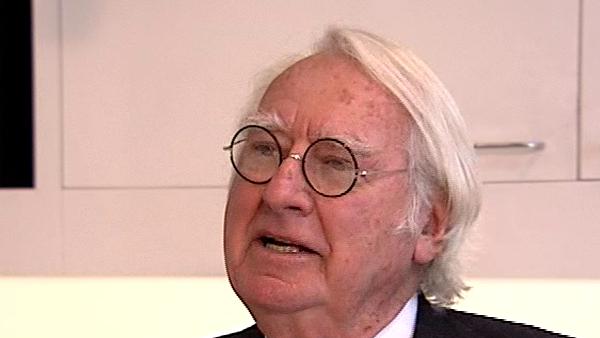NEXT STORY

Le Corbusier's Modulor system
RELATED STORIES

NEXT STORY

Le Corbusier's Modulor system
RELATED STORIES


|
Views | Duration | |
|---|---|---|---|
| 11. The problem with organic architecture | 510 | 03:16 | |
| 12. Le Corbusier's Modulor system | 1065 | 02:54 | |
| 13. A chapel in a meeting room | 179 | 02:35 | |
| 14. Why I developed the metal panels | 378 | 04:46 | |
| 15. Frankfurt and Atlanta: my first museums | 339 | 06:08 | |
| 16. My work in Germany | 133 | 05:18 | |
| 17. The Getty Center | 272 | 03:40 | |
| 18. Why it took 12 years to build the Getty Center | 198 | 01:59 | |
| 19. Public clients versus private clients | 229 | 02:12 | |
| 20. The postmodernism blip | 264 | 02:02 |


Architecture is about making of space. It's about how you show what... how you create places that people move through and live in, and work in and exist in. And going back to the early work and in some ways, my parents' house was very much influenced by Frank Lloyd Wright. I'd been to Fallingwater, you know, the most extraordinary building in the world. I mean, it was nothing like it and Frank Lloyd... and Frank Lloyd Wright... as a student I'd read everything that he'd ever written and you know, you become enamoured with Wright, no matter. You can't help it. And when I did my parents' house, I had brick walls which began in the living room and then extended out into the garden. It seemed to me that this was in keeping with Wright's notion of the extension of space, you know, from interior to exterior. And the walls would then become garden walls and the interior walls would become elements which defined the living room, and dining room and bedroom spaces. Each space then opened out to a garden... these walls and when the house was all finished, I looked at it and you know, I liked it but I said, you know, interior is different from exterior. The minute you put up a glass membrane that wall, which is on the inside, doesn't weather and that wall which is on the outside does weather. You know, moss grows on the brick. It changes color slightly. The outside is not the same as the inside and this notion of organic architecture although it sounds wonderful, is wrong. It can work in certain climates, you know, perhaps in Southern California but in the Northeast, you have to protect the materials. The wood, which you cut down and use as a building material is no longer organic, the tree is dead. You have to protect that wood. You can protect it by staining it or by painting it, so after that I said, you know, architecture is manmade. That which is organic is around us, the changing light of the day, the trees, the... that's organic, so there's a relationship between what's manmade and what's organic. And as an architect, I can only deal with that which is manmade and therefore the painting of white to show that it's manmade, the articulation of space. The whiteness in the way it shows the difference between opacity and transparency, between planar surfaces and linear surfaces are all part of, sort of, the philosophy that began, say, with the Smith house and then developed over the years.
The prominent American architect Richard Meier (b. 1934) is best known for the Getty Centre in Los Angeles, one of his many public projects which broke from his usual style of sleek, white buildings. In all his work – carried out with characteristic refined style – he refuses to bend to the trends of modern architecture. He has won many awards including the Pritzker Prize for Architecture, considered the field's highest honour.
Title: The problem with organic architecture
Listeners: Massimo Vignelli
Massimo Vignelli was born in Milan and studied architecture in Milan and Venice. He is the co-founder and President of Vignelli Associates and Chief Executive Officer of Vignelli Designs in New York. His work includes graphic and corporate identity programs, publication designs, architectural graphics, interiors, furniture, and consumer product designs. His work has been published and exhibited throughout the world and entered in the permanent collections of several museums. He has taught and lectured on design in the major cities and universities in the United States and abroad. Included among Massimo Vignelli's awards are the Gran Premio Triennale di Milano, 1964, the Compasso d'Oro, awarded by the Italian Association for Industrial Design (ADI), 1964 and 1998, the 1982 Art Directors Club Hall of Fame, the 1983 AIGA Gold Medal, the 1992 Interior Product Designers Fellowship of Excellence, The 1995 Brooklyn Museum Design Award for Lifetime Achievement and The 2001 Russel Wright Award for Design Excellence.
Tags: Fallingwater, Frank Lloyd Wright
Duration: 3 minutes, 16 seconds
Date story recorded: March 2007
Date story went live: 23 December 2008